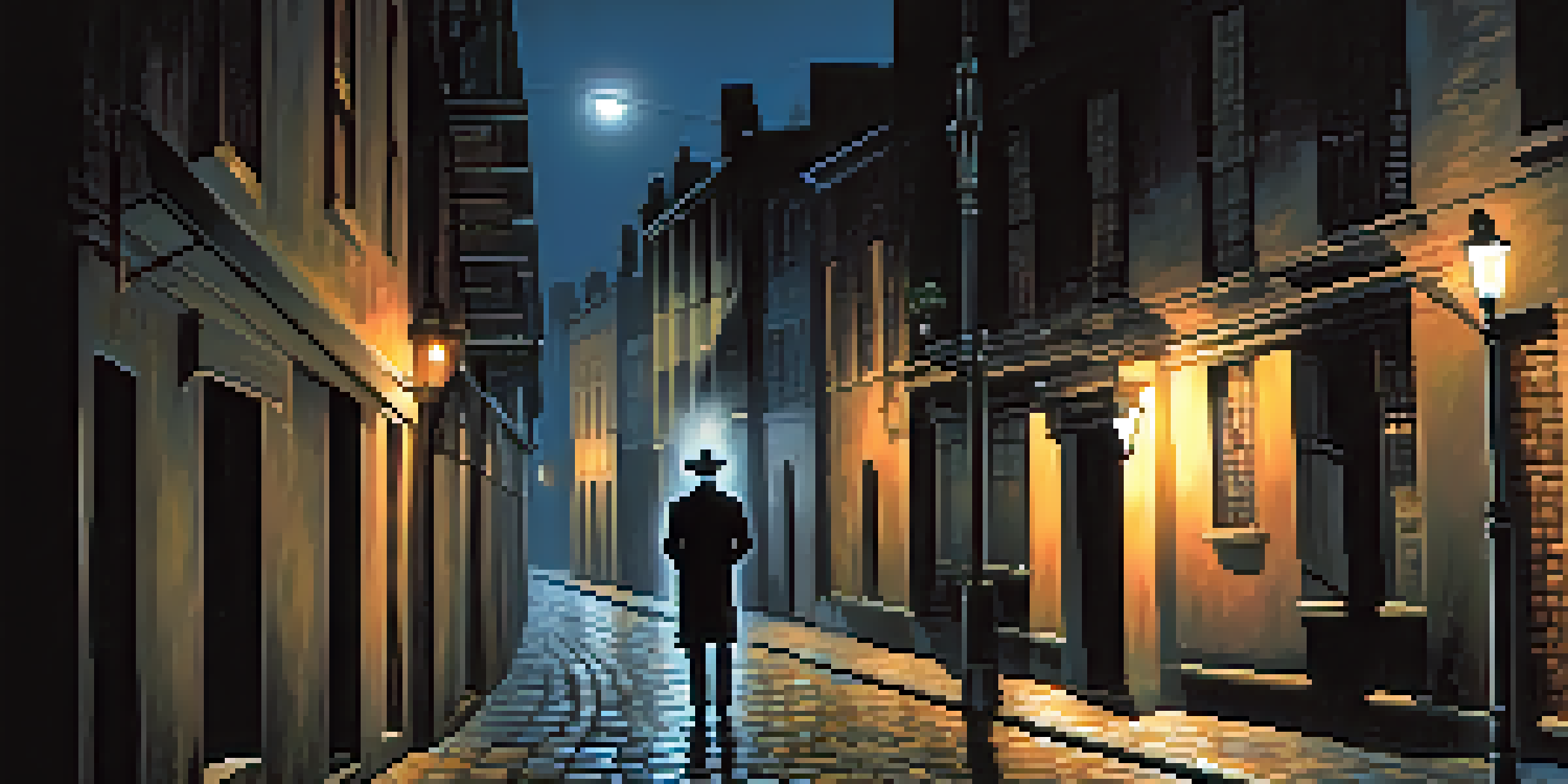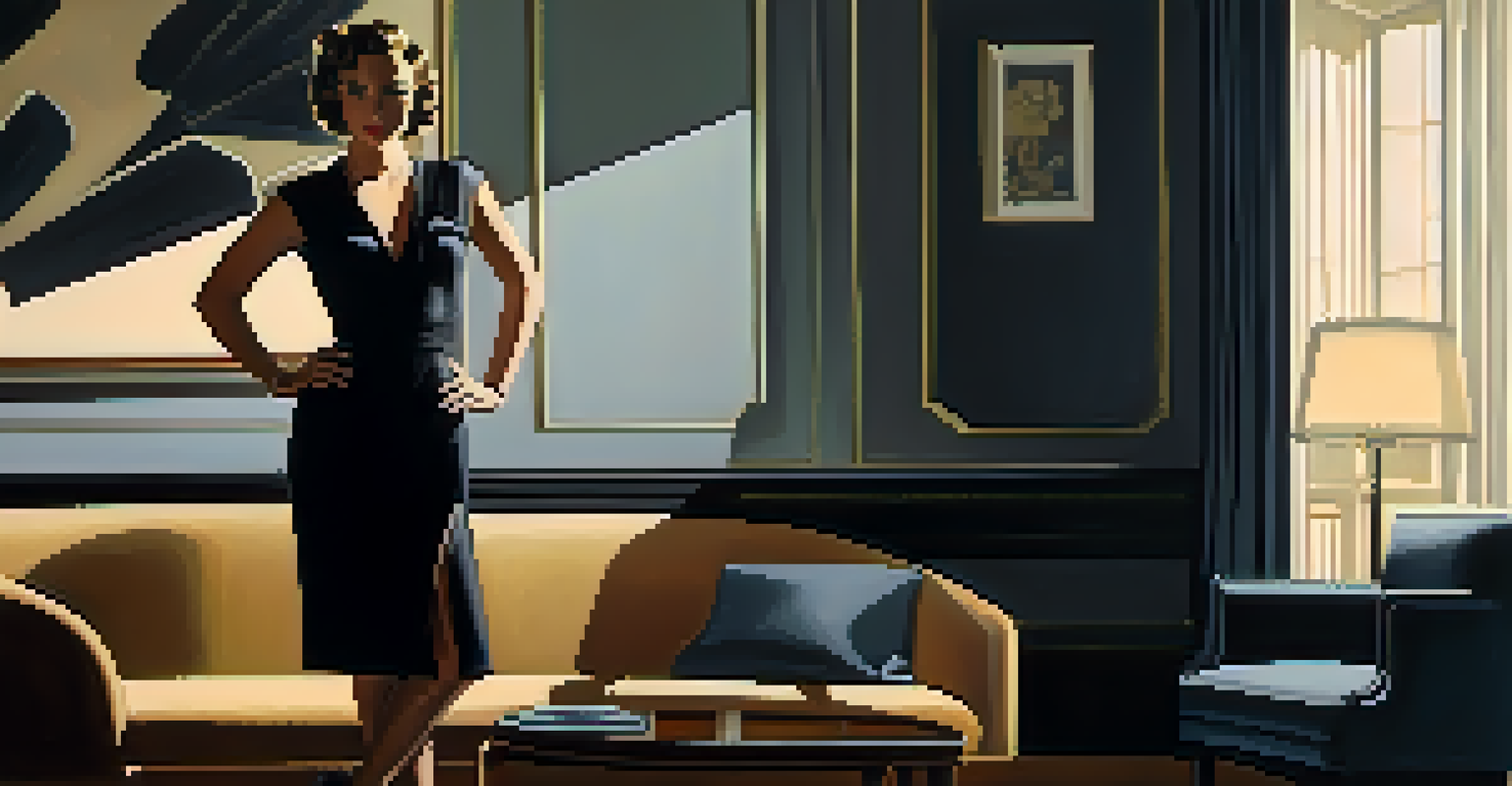Cultural Significance of Film Noir in Mid-20th Century America

The Origins of Film Noir in American Cinema
Film noir emerged in the early 1940s, primarily influenced by German expressionism and hard-boiled detective fiction. The gritty, shadowy aesthetic captured the disillusionment of a post-war society grappling with its identity. Movies like 'The Maltese Falcon' set the tone for this genre, showcasing morally ambiguous characters and complex narratives. This marked a significant shift from the idealism prevalent in earlier Hollywood films, reflecting a society in turmoil.
Film noir is the most American of all film genres, and perhaps the most pessimistic. It reflects the disillusionment and the darker side of the American Dream.
As the genre developed, filmmakers began to explore darker themes, such as betrayal and existential dread. The use of chiaroscuro lighting emphasized the moral complexities faced by the protagonists, often portrayed as anti-heroes. This visual style not only created a unique atmosphere but also mirrored the societal anxieties of the time, such as the fear of communism during the Cold War. Thus, film noir became a lens through which audiences could examine their own uncertainties.
Ultimately, the origins of film noir laid a foundation for a new wave of storytelling in American cinema. By incorporating elements of crime, psychological tension, and a sense of realism, these films resonated with viewers and reflected their lived experiences. The genre's roots in literature and art further enriched its narrative depth, making it a significant cultural phenomenon.
Film Noir as a Reflection of Social Issues
Film noir didn't just entertain; it served as a mirror to the social issues of mid-20th century America. Themes of corruption, moral ambiguity, and the struggles of the working class resonated deeply with audiences who were facing their own challenges in a rapidly changing world. The portrayal of women in these films, often as femme fatales, also sparked discussions about gender roles and societal expectations. These characters were complex, showcasing both strength and vulnerability, which made them relatable and intriguing.

Moreover, the post-war era saw a rise in crime and urban decay, which provided fertile ground for noir narratives. Cities were depicted as dangerous and unforgiving, reflecting the anxieties associated with urbanization and social upheaval. Films like 'Double Indemnity' illustrated how greed and betrayal could lead to destruction, mirroring the fears of a society grappling with economic instability. This connection between film and reality allowed viewers to engage with the stories on a deeper level.
Film Noir Reflects Social Issues
The genre served as a mirror to mid-20th century America, addressing themes of corruption, gender roles, and the struggles of the working class.
As audiences watched these films, they were not just passive consumers; they became participants in a dialogue about their own lives. The gritty realism of film noir prompted viewers to confront uncomfortable truths about their society, making the genre a powerful vehicle for social commentary. In this way, film noir transcended mere entertainment and evolved into a platform for exploring the complexities of human nature and societal flaws.
Influence of WWII on Film Noir Themes
World War II had a profound impact on the themes and narratives found in film noir. The war brought about a sense of disillusionment and trauma, which filmmakers channeled into their stories. Characters often grappled with issues of loyalty, loss, and the psychological scars left by conflict. This exploration of human fragility became a hallmark of the genre and added depth to the characters' struggles.
Noir is not a genre. It's a mood, a feeling. It's about the darkness that exists in the human soul.
In many noir films, veterans returned home only to find a society that had changed dramatically, leaving them feeling alienated. The portrayal of these disenchanted characters reflected the experiences of countless individuals who had fought in the war, highlighting the emotional toll of conflict. This theme of dislocation is evident in films like 'The Postman Always Rings Twice,' where characters are trapped in a cycle of violence and despair.
Thus, the influence of WWII on film noir not only shaped individual character arcs but also contributed to the overall atmosphere of the genre. It provided a rich backdrop against which these stories unfolded, making them all the more poignant. The interplay between war and personal struggle added a layer of complexity that resonated with audiences, reinforcing the cultural significance of film noir during this tumultuous period.
The Role of Gender in Film Noir
Gender dynamics play a crucial role in the narratives of film noir, often challenging traditional roles and expectations. The femme fatale, a central archetype in many noir films, embodied a mix of allure and danger, complicating the notion of femininity. Characters like Phyllis Dietrichson in 'Double Indemnity' showcased women who wielded power through their sexuality, defying the era's norms. This portrayal offered a fresh perspective on gender relations, sparking conversations that extended beyond the screen.
On the other hand, male characters often grappled with their own vulnerabilities in the presence of these strong women. They were frequently depicted as flawed and susceptible to manipulation, highlighting the shifting power dynamics of the time. This tension between male and female characters created a rich narrative landscape, where both genders were portrayed with depth and complexity. It also allowed audiences to question societal expectations around masculinity and femininity.
Impact of WWII on Film Noir
World War II profoundly influenced film noir, adding themes of disillusionment and alienation as characters grappled with their wartime experiences.
Ultimately, the exploration of gender in film noir contributed to its cultural significance, as filmmakers pushed boundaries and challenged conventions. The genre provided a space for discussing issues of power, identity, and morality, making it relevant to the evolving social landscape of mid-20th century America. Through its multifaceted characters and storylines, film noir became a commentary on the complexities of human relationships.
Visual Style and Aesthetics of Film Noir
The visual style of film noir is one of its most defining characteristics, using lighting, camera angles, and set design to create a unique atmosphere. The use of low-key lighting and stark contrasts established a sense of tension and foreboding, immersing viewers in the story. Shadows played a significant role, symbolizing the moral ambiguity of the characters and their choices. This aesthetic not only set the mood but also enhanced the narrative, drawing audiences deeper into the film's world.
Cinematography in noir films often employed unconventional angles and framing to evoke feelings of unease. For instance, the use of oblique angles could suggest instability or danger, mirroring the tumultuous emotions of the characters. The urban settings, with their dimly lit alleyways and smoky bars, further contributed to the genre's gritty realism. These visual choices created a distinctive style that has influenced countless filmmakers and genres since.
The aesthetics of film noir are not just about visual appeal; they also serve as a storytelling device. By crafting a specific atmosphere, filmmakers were able to convey complex emotions and themes without relying solely on dialogue. This innovative approach to visual storytelling set film noir apart from other genres and established it as a significant movement in American cinema. Its legacy continues to inspire filmmakers today, demonstrating the enduring power of its visual language.
Film Noir and the American Dream
Film noir often presents a critical perspective on the American Dream, exposing its darker underbelly. While this ideal promotes prosperity and happiness, noir films reveal the struggles individuals face in pursuit of it. Characters are frequently depicted as desperate, resorting to crime and deceit to achieve their goals, highlighting the disillusionment that can accompany the quest for success. This disconnection between the dream and reality adds a layer of complexity to the narratives.
In many cases, the protagonists are portrayed as anti-heroes, embodying the idea that the pursuit of the American Dream can lead to moral decay. Films like 'The Big Sleep' illustrate how wealth and ambition can corrupt individuals, leaving them trapped in a cycle of violence and betrayal. This critique of the American Dream resonated with audiences who were grappling with their own aspirations and disappointments in the post-war era.
Legacy of Film Noir in Cinema
Film noir's distinctive style and themes continue to inspire modern filmmakers, remaining relevant as they adapt its elements to contemporary narratives.
Ultimately, film noir serves as a cautionary tale about the pursuit of success at any cost. By exposing the darker aspects of the American Dream, the genre invites viewers to reflect on their values and the societal pressures that drive them. This exploration of ambition and morality adds depth to the narratives, making film noir a significant commentary on the complexities of the human experience.
The Legacy of Film Noir in Modern Cinema
The influence of film noir extends far beyond its mid-20th century origins, leaving a lasting legacy in modern cinema. Contemporary filmmakers often draw inspiration from the genre's distinctive visual style and complex narratives, infusing their own stories with noir elements. Movies like 'Se7en' and 'Chinatown' pay homage to the classic tropes of film noir while exploring new themes and contexts. This evolution showcases how timeless the genre's themes of morality, identity, and human nature remain.
Additionally, the resurgence of neo-noir films in the late 20th and early 21st centuries demonstrates the genre's ongoing relevance. These modern interpretations often blend traditional noir elements with contemporary issues, reflecting the changing social landscape. Films like 'Blade Runner' and 'Memento' incorporate noir aesthetics while addressing themes such as technology and memory, proving that the genre can adapt to current societal concerns.

Ultimately, film noir has solidified its place in the pantheon of cinematic history, influencing countless filmmakers and genres. Its exploration of the human condition continues to resonate with audiences, fostering a deeper understanding of the complexities of life. As long as stories of struggle, ambition, and moral ambiguity exist, the spirit of film noir will endure, shaping the future of storytelling in cinema.